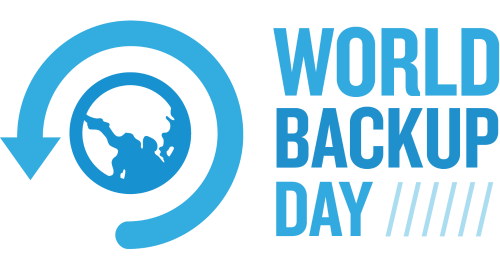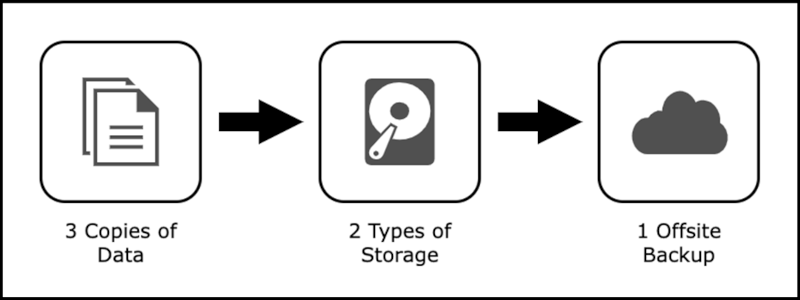World Backup Day 2022

Once again it is March 31st, which is World Backup Day. It is an official/non-official day to ensure that you have backed up your data. To learn more about this initiative you should take time to visit the World Backup Day website.
Much like the times that I have posted about this topic before, I have known several people who lost a significant amount of data in the last year and that data loss was almost entirely avoidable in every instance. This is unfortunate, because it has never been easier to backup your data automatically with operating system integrated solutions such as OneDrive and iCloud. Despite the supply chain issues that have been present since the beginning of the COVID-19 Pandemic, storage is still relatively cheap and readily available. An external 1TB USB drive (non-SSD) from a reputable vendor can usually be found for less than $100, and for the vast majority of people that is sufficient storage for their personal data.
I spent a lot of time at the end of 2021 going through around 10 years worth of my data, removing duplicates, better organizing it, and I was able to streamline my regular backup regiment to ensure that I never lose any data. I wanted to ensure that I was following best practices, and the 3-2-1 backup rule which is still the standard that I follow for managing backups.
3-2-1 Backup Rule
The 3-2-1 backup rule means having your data backed up and available in the following manner:
- Create one primary backup and two copies of your data.
- Save your backups to two different types of media.
- Keep at least one backup offsite.
Not that this is a particularly useful diagram explaining the process, but on a high-level it looks something like this:

There are a few ways to interpret this backup philosophy, but it actually isn’t very difficult to understand.
- Always have three copies of your important data, one primary and two backups. This may seem redundant but having multiple copies can help prevent corruption issues on different backup types and gives you the ability to compare backup data should the question of data corruption ever arise.
- Always use two different types of media to store your backups. Every media type deteriorates over time, so it is important to use different media types if possible. Just to put it in perspective, storing your data on a traditional spinning HDD and an SSD could be interpreted as different storage media.
- Always keep a backup offsite and offline. This protects the data from being destroyed if you have a fire, flood, or other damage to your residence/office. Keeping it offline prevents the data from changing, which can help with the first step of allowing the backup data to be compared if needed.
The availability of easy to use and cheap cloud storage certainly simplifies this process and allows for easy revision control, but it is important to always utilize more old-fashioned backup solutions to ensure that your data is safe. Cloud storage does not make the 3-2-1 backup rule obsolete in any way, but I believe that it just makes available another storage medium.
I mentioned earlier that I made changes to my regular backup practices, and here is what I do to achieve the 3-2-1 backup rule for my data:
- I have 3 external disk drives that are dedicated entirely for backup purposes. All of them are encrypted with different methods. I keep them in separate carrying cases with the necessary USB cables to ensure that I always have them.
- One of the disks is primarily used with Time Machine on my MacBook Air which is my primary computer, and it runs multiple times per day. The other 2 disks are meant to be stored offsite and are swapped monthly with the most up-to-date backups of all data. The Time Machine drive and one of the monthly backup disks are my primary backups that I keep at home and are readily available.
- I have two Cloud storage solutions that I use, and that is with OneDrive and iCloud Drive. All of data is continually backed up throughout the day to both solutions.
- Twice a year I backup all of my most critical data (legal documents, financial documents, etc.) to Blu-ray discs. I keep one copy onsite and one offsite.
I have reminders in my calendar to ensure that the offsite backups are being maintained properly, and I ensure that I don’t defer offsite backups for more than a few days. Life happens, so sometimes it isn’t easy to swap the offsite backups.
Aside from that, I also backup all of my code to Git on a daily basis if I am working on anything important. I also use other solutions such as Google Photos for backing up photos, but those are included in my regular physical backups.
Use Your Own Backup System
The 3-2-1 backup rule can be extreme if you are just backing up your personal data but use your own judgement. Do yourself a favour, open your documents folder on your computer and ask yourself these questions:
- Is this data important?
- Can I afford to lose this data?
- If I lose this data, can I get it back?
If the data is important, if you can’t afford to lose it and you can never get it back, take some time to do a backup of your data. It isn’t difficult to do and you don’t require any special software to do it. Just copy and paste it to an external disk, or copy it to a cloud storage provider and you are set. If possible, utilize encryption for your backed up data, just in case.
Like with a lot of things in life, it is better to have something just in case, because you never know what is going to happen. You would rather be looking at a backup copy of your data, than looking for a backup copy of your data.